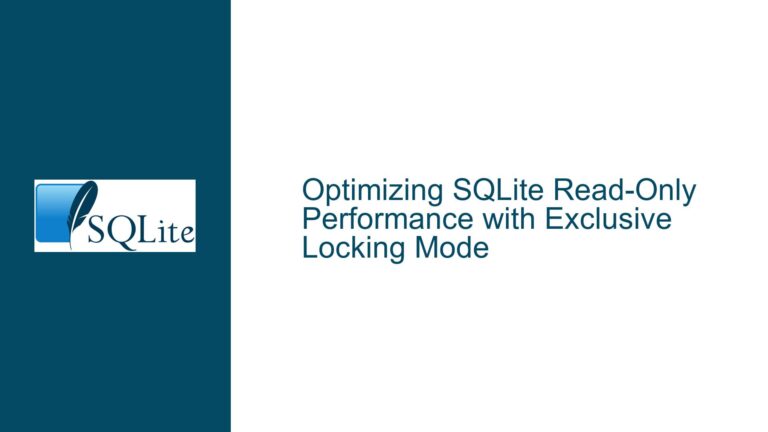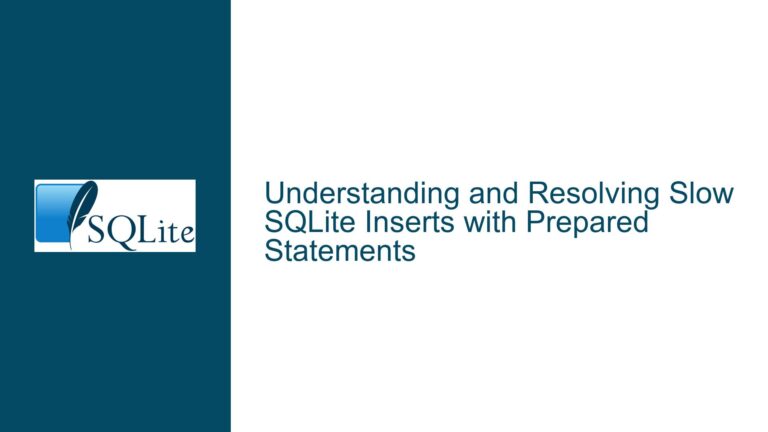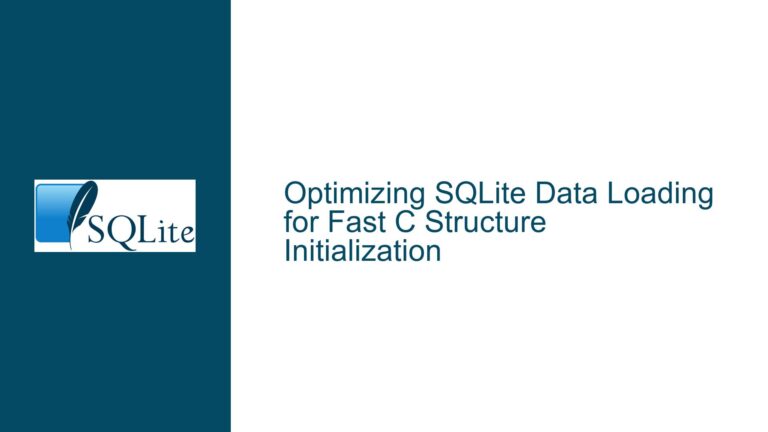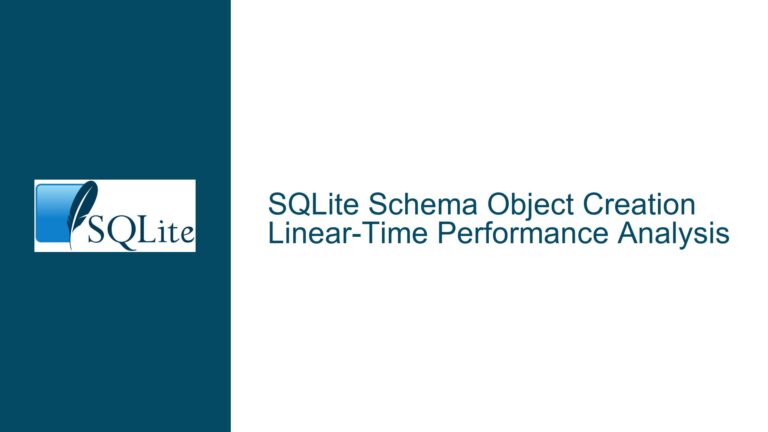Assertion Failure in SQLite Indexed Expression Optimization
Issue Overview: Assertion Failure in sqlite3ExprCodeTarget During Query Execution
The core issue revolves around an assertion failure in SQLite when executing a specific query involving an indexed expression and a RIGHT JOIN. The assertion failure occurs in the sqlite3ExprCodeTarget function, specifically at the line where the assertion pExpr->iAgg>=0 && pExpr->iAgg<pAggInfo->nColumn is evaluated. This failure indicates that the expression being processed (pExpr) has an invalid aggregate index (iAgg), which is either negative or exceeds the number of columns in the aggregate information structure (pAggInfo).
The query in question involves creating a table v1 with two columns (c1 and c2), defining a unique index i on an expression (c1 + c2), and then performing a SELECT statement with a RIGHT JOIN and a GROUP BY clause. The failure is triggered when SQLite attempts to optimize the query using the SQLITE_IndexedExpr optimization. Disabling this optimization (via .testctrl optimizations 0x01000000) allows the query to execute without crashing, suggesting that the issue is directly related to how SQLite handles indexed expressions in the presence of certain query constructs.
The problem was initially identified through a bisecting process, which pinpointed the issue to a specific commit range (e06973876993926f to 35f10a06ba81b8a5). A patch was later provided (ffe23af73fcb324d) to address the issue, but understanding the root cause and the implications of the fix requires a deeper dive into SQLite’s internals.
Possible Causes: Invalid Aggregate Index in Indexed Expression Optimization
The assertion failure in sqlite3ExprCodeTarget suggests that the issue lies in how SQLite processes aggregate expressions during query execution. Specifically, the failure occurs when SQLite attempts to use an indexed expression (c1 + c2) in the context of a RIGHT JOIN and GROUP BY clause. The invalid aggregate index (iAgg) indicates that SQLite’s optimizer is either incorrectly assigning an index to the expression or failing to properly account for the expression’s context within the query.
One possible cause is that the SQLITE_IndexedExpr optimization is not correctly handling the interaction between indexed expressions and aggregate functions in the presence of complex joins. When SQLite optimizes a query, it attempts to replace expressions with their indexed equivalents to improve performance. However, in this case, the optimization process may be incorrectly mapping the indexed expression (c1 + c2) to an aggregate context, leading to an invalid index assignment.
Another potential cause is that the query’s structure (specifically, the RIGHT JOIN and GROUP BY clauses) is causing SQLite to generate an incorrect execution plan. The RIGHT JOIN operation may be altering the way SQLite processes the indexed expression, leading to a mismatch between the expression’s expected context and its actual usage in the query. This mismatch could result in the invalid aggregate index that triggers the assertion failure.
Additionally, the issue may be related to how SQLite handles the GROUP BY clause in conjunction with indexed expressions. The GROUP BY clause requires SQLite to group rows based on the specified columns, which may interfere with the optimizer’s ability to correctly process indexed expressions. If the optimizer fails to account for the grouping operation, it may incorrectly assign an aggregate index to the expression, leading to the assertion failure.
Troubleshooting Steps, Solutions & Fixes: Diagnosing and Resolving the Assertion Failure
To diagnose and resolve the assertion failure, it is essential to understand the underlying mechanisms of SQLite’s query optimization and execution processes. The following steps outline a comprehensive approach to troubleshooting the issue:
Step 1: Reproduce the Issue in a Controlled Environment
The first step in troubleshooting the issue is to reproduce it in a controlled environment. This involves creating the table v1 with the specified columns (c1 and c2), defining the unique index i on the expression (c1 + c2), and executing the problematic query. The query should include the RIGHT JOIN and GROUP BY clauses, as these are critical to triggering the assertion failure.
CREATE TABLE v1 ( c1, c2 );
CREATE UNIQUE INDEX i ON v1 (c1, c1+c2);
SELECT count( a1.c1+a1.c2 ) FROM v1 AS a1 RIGHT JOIN v1 GROUP BY a1.c1;
By reproducing the issue, you can confirm that the problem is consistent and not caused by external factors such as data corruption or environmental differences.
Step 2: Analyze the Query Execution Plan
Once the issue is reproduced, the next step is to analyze the query execution plan. SQLite provides several tools for examining the execution plan, including the EXPLAIN and EXPLAIN QUERY PLAN commands. These commands allow you to see how SQLite is processing the query and identify any potential issues with the execution plan.
EXPLAIN QUERY PLAN
SELECT count( a1.c1+a1.c2 ) FROM v1 AS a1 RIGHT JOIN v1 GROUP BY a1.c1;
The output of the EXPLAIN QUERY PLAN command will show the steps SQLite is taking to execute the query, including the use of indexes and the order of operations. Pay close attention to how SQLite is handling the indexed expression (c1 + c2) and the RIGHT JOIN operation. If the execution plan shows unexpected behavior, such as the misuse of the indexed expression, this could indicate a problem with the optimizer.
Step 3: Disable the SQLITE_IndexedExpr Optimization
As mentioned in the original discussion, disabling the SQLITE_IndexedExpr optimization allows the query to execute without crashing. This suggests that the issue is directly related to this optimization. To disable the optimization, you can use the .testctrl command with the appropriate flag:
.testctrl optimizations 0x01000000;
After disabling the optimization, re-run the query to confirm that the assertion failure no longer occurs. This step helps isolate the issue to the SQLITE_IndexedExpr optimization and provides further evidence that the problem lies in how SQLite handles indexed expressions in certain contexts.
Step 4: Examine the SQLite Source Code
To gain a deeper understanding of the issue, it is necessary to examine the SQLite source code, specifically the sqlite3ExprCodeTarget function and the surrounding code. The assertion failure occurs in this function, indicating that the problem is related to how SQLite processes expressions during query execution.
The sqlite3ExprCodeTarget function is responsible for generating code to evaluate an expression and store the result in a target register. The assertion pExpr->iAgg>=0 && pExpr->iAgg<pAggInfo->nColumn ensures that the aggregate index (iAgg) is valid. If this assertion fails, it means that the expression being processed has an invalid aggregate index, which could be due to an error in the optimizer or the query execution plan.
By examining the source code, you can trace the flow of execution and identify where the invalid aggregate index is being assigned. This may involve looking at how SQLite handles indexed expressions, aggregate functions, and complex joins. Understanding the code will also help you determine whether the issue is a bug in SQLite or a result of incorrect query construction.
Step 5: Apply the Provided Patch
The original discussion mentions a patch (ffe23af73fcb324d) that addresses the issue. If you have access to the SQLite source code, you can apply this patch and recompile SQLite to see if it resolves the assertion failure. Applying the patch involves downloading the latest version of SQLite, applying the patch file, and then compiling SQLite with the appropriate flags.
# Download the latest SQLite source code
wget https://www.sqlite.org/src/tarball/sqlite.tar.gz
tar -xzf sqlite.tar.gz
cd sqlite
# Apply the patch
patch -p1 < ffe23af73fcb324d.patch
# Compile SQLite with debugging flags
export CFLAGS="-g -O0 -DSQLITE_DEBUG -DSQLITE_ENABLE_TREETRACE -DSQLITE_ENABLE_WHERETRACE -DSQLITE_ENABLE_CURSOR_HINTS -DSQLITE_COUNTOFVIEW_OPTIMIZATION -DSQLITE_ENABLE_STAT4"
./configure
make
After applying the patch and recompiling SQLite, re-run the query to confirm that the assertion failure no longer occurs. If the patch resolves the issue, it indicates that the problem was indeed a bug in SQLite’s handling of indexed expressions.
Step 6: Verify the Fix and Test Edge Cases
Once the patch is applied and the issue appears to be resolved, it is important to verify the fix and test edge cases to ensure that the problem is fully addressed. This involves running the original query as well as other queries that involve indexed expressions, RIGHT JOIN operations, and GROUP BY clauses. The goal is to confirm that the fix does not introduce new issues and that SQLite handles these query constructs correctly.
Additionally, you should test the fix with different data sets and query variations to ensure that it is robust and does not break under different conditions. This step is crucial for ensuring that the fix is reliable and that SQLite’s query optimization and execution processes are functioning as expected.
Step 7: Monitor for Future Issues
Even after applying the patch and verifying the fix, it is important to monitor for future issues that may arise. SQLite is a complex system, and changes to one part of the code can have unintended consequences elsewhere. By keeping an eye on SQLite’s behavior and monitoring for any new assertion failures or unexpected query results, you can quickly identify and address any issues that may arise.
In conclusion, the assertion failure in sqlite3ExprCodeTarget is a complex issue that requires a thorough understanding of SQLite’s query optimization and execution processes. By following the troubleshooting steps outlined above, you can diagnose the issue, apply the necessary fixes, and ensure that SQLite handles indexed expressions and complex query constructs correctly.






